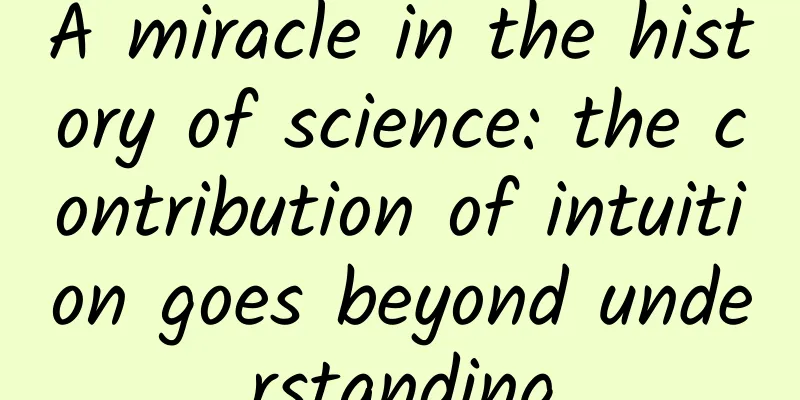A miracle in the history of science: the contribution of intuition goes beyond understanding

|
Faced with more than 60 known elements, all chemists wanted to organize them into a system, but only one person succeeded: he made a table with many blank spaces, like a Sudoku puzzle to be solved. And he never claimed to understand the meaning of the structure and periodicity of this table. This article is authorized to be excerpted from "Gallery of Science" (People's Posts and Telecommunications Press), and the title is added by the editor. By John D. Barrow Translated by Tang Jing and Li Pan The periodic table is used in all chemistry studies, and there is no doubt that if humans ever make contact with life beyond Earth, one of the things both civilizations will have in common is an orderly, familiar table of elements. —John Emsley[1] Following Aristotle, ancient Greek philosophers believed that matter, in all its forms, could be summarized in four basic substances: earth, fire, air, and water. This simple idea was revered as fact until the 17th century, when chemistry, derived from alchemy, led to the discovery of other elements. Earth was not a single substance, and air was not made up of just one gas. In the 18th century, the spectrum of elements experienced dramatic growth. Many new metals were discovered, such as cobalt, nickel, manganese, tungsten, chromium, magnesium, and uranium, and new gases, such as hydrogen, nitrogen, oxygen, and chlorine, were isolated for the first time. The concept of "element" in chemistry was first proposed by Robert Boyle: a substance that cannot be further decomposed by physical processes is an element. Later, French chemist Antoine-Laurent de Lavoisier [2] officially named the elements in 1789 [3]. Lavoisier selected 33 substances, defined their elemental states, and divided them into four groups: metals, non-metals, earth, and gases. Later, people discovered that some of these elements were actually compounds, and others, such as heat and light, were not even chemical substances. Below is Lavoisier's table of the elements. Only the elements marked in red are still considered chemical elements today. Gas: heat, light, hydrogen, nitrogen, oxygen. Soil: alumina, barite, lime, magnesia, silica. Metals: antimony, arsenic, bismuth, cobalt, copper, gold, iron, lead, manganese, mercury, molybdenum, nickel, platinum, silver, tin, tungsten, zinc. Nonmetals: sulfur, phosphorus, carbon, chlorides, fluorides, borates. The "earth" group here is actually oxides, such as lime is calcium oxide, and silica is silicon dioxide. However, under the conditions at the time, Lavoisier could not extract oxygen atoms from compounds and recognize related elements independently. Other false elements are in the "non-metal" group. Similarly, Lavoisier could not separate these elements into individual elements such as chlorine, fluorine and boron with the technology at the time. During the French Revolution, Lavoisier became an enemy of Jean-Paul Marat and was eventually guillotined during the "Reign of Terror" in 1794 due to his involvement in a national tax scandal. The judge declared: "The Republic does not need geniuses." But just 18 months later, the revolutionary government changed its tune and said that Lavoisier was actually wronged. Then a science teacher from Manchester, England, took this research a step further. In 1805, John Dalton presented a paper to the Manchester Literary and Philosophical Society explaining the various ways elements could combine with each other, and how the basic ingredients formed different weights. At the time, most chemists thought atoms were too small to study. But Dalton was more adventurous, and he came up with a table of 20 elements and their weights, with symbols that showed how they combined. Matter was represented by pictures, with patterns of its basic components. From this table, more compounds could be derived: Compound 21 was water, described as HO; Compound 22 was ammonia, described as NH. These representations were the beginnings of the chemical equations we all know today. Dalton was stunned by the new complexity of the chemical language. After seeing the new scheme, he said, "A young chemistry student must learn Hebrew." New elements were constantly being discovered, and Humphry Davy used electrolysis to break down Lavoisier's original "earth group elements" into real elements. By 1863, there were more than 60 elements. Is there a limit to the "big bang" of elements? The 20 elements classified by John Dalton in 1805 and their weights This was a fascinating question at the time. If there is a limit, how many elements are there? What factors actually determine this limit? In the 19th century, many brave attempts were made to classify elements based on their weight, properties, etc. All the best chemists of the time[7] would have built a similar system[8]. However, they were all beaten by a Russian chemistry professor from Siberia. Dmitri Ivanovich Mendeleev was born in 1822 in Tobolsk, Siberia, to a local primary school principal. He had 13 siblings. Mendeleev’s mother was convinced that her son had special talents and should receive all the quality education possible, so she sent him to school in St. Petersburg. She was right. While at university, Mendeleev was always at the top of his class. He then went to work in France, and then to Heidelberg, Germany, as an assistant to the then-prominent German chemist Robert Bunsen. Finally, in 1867, Mendeleev returned to St. Petersburg to become a professor of chemistry at the university.[9] One spring day in 1867, Mendeleev was staying home due to bad weather, so he took the opportunity to continue writing a new textbook called "Principles of Chemistry". He was at a loss as to how to display and arrange the rapidly increasing number of elements and their properties. So he wrote the name of each element on a card, and next to it he noted some of the properties of the corresponding element, as well as its oxides and hydrides. Then he began to arrange the cards in various ways, trying to find a pattern: elements with the same valence were placed horizontally, and elements were arranged vertically in descending order of atomic weight. Suddenly, he found a very distinctive arrangement. He wrote down his results on the back of an old envelope, which can still be seen in St. Petersburg today[10]. Mendeleev sketched out the original periodic table in 1867 Next, Mendeleev invented a simpler version. He arranged the first seven elements, lithium to fluorine, horizontally in order of increasing atomic weight[11], and then arranged the seven elements, sodium to chlorine, in the same way. Thus, periodicity emerged: in the vertical column, two elements with similar chemical properties were next to each other, and in the seven columns, the first element in the first column had a principal valence of 1, the next one had a principal valence of 2, and then 3, 4, 3, and 1. Then, Mendeleev soon discovered that if he flipped the table and swapped the rows and columns, the table would be clearer. We can still recognize this result today, even though many new elements have been added to the table. There are eight columns, or periods, in the table. In a major refinement in 1870, Mendeleev assigned the 63 known elements to 12 rows, starting with hydrogen and ending with uranium, with each element placed in a column with similar chemical properties and arranged in ascending order of atomic weight. One of the most important intuitive contributions of Mendeleev’s table was the prediction of new elements. He did not, as others had done, put all the known elements in a complete periodic table. Aristotle would have done that. Mendeleev believed that if the periodic table had a logical structure, it would mean that there would be gaps in the table. He speculated that new elements would fill these gaps, and that the periodicity of the table would allow predictions of atomic weights and atomic densities. Below boron, aluminum, and silicon, he speculated on three “undiscovered” elements, which he named “boron-like,” “aluminum-like,” and “silicon-like.”[12] These three elements were discovered one after another, and their atomic weights and densities were consistent with Mendeleev's predictions: "Aluminum-like" was discovered in Paris, France in 1875 and was called gallium (France in Latin); "boron-like" was discovered in Uppsala, Sweden in 1879 and was called scandium (Scandinavia in Latin); "silicon-like" was discovered in Freiberg, Germany in 1886 and was called germanium (germanium in Latin). Mendeleev also predicted a new member of the fourth group (titanium), with an atomic weight of about 180. This element was finally discovered in 1923 at the University of Copenhagen, Denmark, with an atomic weight of 178.5 and was named hafnium (Copenhagen in Latin). In 1893, Mendeleev became the head of the Russian Bureau of Weights and Measures and made an admirable contribution. He formally defined the composition of vodka: one molecule of alcohol plus two molecules of water. The molecular weight showed that vodka was composed of 38% alcohol and 62% water. In 1894, the legal standard issued by the Russian Bureau of Weights and Measures slightly adjusted this figure to 40% alcohol and 60% water. This is 80% proof (1 proof is equal to 2 times the volume of alcohol). Gerald Holton once made the following analogy about Mendeleev’s achievement and its profound influence on contemporary scientists: “It is as if a librarian put all the books in a pile, weighed them one by one, and arranged them on different shelves in ascending order of weight. Then, he suddenly discovered that the first book on each shelf was about art, the second about philosophy, the third about science, the fourth about economics, and so on. Our librarian may not understand the inner workings of these rules, but once he discovers that the books on one of the shelves are in the order ‘art-science-economics’, he will leave a gap between the art books and the science books and start looking for the missing philosophy book of the right weight.”[13] We can see the periodicity of the periodic table from a property of the elements, such as the atomic volume divided by the atomic weight. This was first discovered by Julius Meyer in 1870.[14] The alkali metals appear at the top of the chart. Mendeleev never claimed to understand the meaning of the structure and periodicity of the table. It was a great intuitive leap. He believed that the elements had an inherent symmetry, but he never imagined that his table would be a handy search tool that would eventually lead to dramatic discoveries and predictions. Although Mendeleev could not discover the pattern of the elements before him, he knew that this table would help others to do so. The modern version of the periodic table[15] has seven rows (periods), with 2, 8, 8, 18, 18, 32, and 32 elements in each row. This pattern became understandable after the discovery of the quantum theory of the atom. The quantum wave nature of electrons means that only integer multiples of the wavelength can "load" electrons into orbits. The increasing number of elements in each row of the periodic table reflects the increasing number of electrons in orbit around the nucleus of each atom. Quantum mechanics allows the innermost orbit (called a shell) to contain two electrons, followed by six, then 10 and 14. In the resulting periodic table, the number of elements in each row is the number of electrons that would be in the orbital if it were full, so 8 = 2 + 6, 18 = 2 + 6 + 10, and 32 = 2 + 6 + 10 + 14. The elements in each row are arranged in ascending order by atomic number, and in each column by the same number of electrons in the outermost shell, giving us our modern periodic table. In each row, we regularly add electrons to the orbital until it is full, and we end up with the noble (or inactive) gases at the far right of the periodic table. Then we open the next row and fill the next level of orbitals. It is worth noting that Mendeleev had figured out this pattern before electrons and protons were discovered. He studied atomic weight (determined by the number of protons in the nucleus of an element) and valence (determined by the fullness of the electrons in the orbital), and used this simple method to find the nature of these two chemical properties. Today, Mendeleev’s periodic table appears on the walls of every chemistry laboratory in the world.[16] It seems that his mother’s decision was right. Mendeleev's periodic table. This is the first edition of the periodic table by Russian chemist Dmitri Mendeleev, printed in 1869. He left blanks in the table for new elements. Scientists later discovered these elements, proving Mendeleev's theory. This edition listed the elements with chemical symbols and ordered by atomic weight, but the complete order of the elements was not yet available. In the final edition of 1871, the atoms were arranged in the columns or groups we know today. Notes [1] EMSLEY J. Nature's Building Blocks. Oxford: Oxford UP, 2003: 527. [2] LAVOISIER A. Traité élémentaire de chimie. 1789. This was a textbook for the promotion of the new chemistry and played an important role in chemical education for many years. [3] This is reminiscent of the modern definition of elementary particles. Of course, Lavoisier did not know the internal structure of the atom: protons and neutrons, made up of quarks, make up the nucleus, which is surrounded by electrons. [4] BERZELIUS J J. "Essay on the Cause of Chemical Proportions, and on Some Circumstances Relating to Them: Together with a Short and Easy Method of Expressing Them". Annals of Philosophy. 181(32): 443-454. 353-364. reproduced in DM Knight (ed.). Classical Scientific Papers. New York: American Elsevier, 1968. [5] In 1804, Berzelius heard Dalton give a lecture at the Royal Society in London and had a discussion with him, which led him to learn about Dalton's research. [7] Of these, the work of Julius Meyer is perhaps the most noteworthy. In 1868, he plotted the atomic volumes and atomic weights of 49 elements and discovered periodic variations. He prepared a paper for a friend to comment on, but unfortunately the friend was slow to respond and never completed it. As a result, Mendeleev published a more comprehensive version before Meyer. [8] In 1815, British chemist William Prout devised a detailed list in which all elements were made of hydrogen, which became known in the 19th century as the "Prout hypothesis". [9] POSIN D Q. Mendeleyev: The Story of a Great Scientist. New York: McGraw-Hill, 1948. [10] On view at the Mendeleev Museum and Archives at Saint Petersburg University. [11] Hydrogen was ruled out due to its unique properties, and noble gases (such as helium) had not yet been discovered. [12] In Greek, the prefix eka means "to follow." [13] HOLTON G. Introduction to Concepts and Theories in Physical Science. 2nd rev. ed with S. Brush. Princeton: Princeton UP, 1985: 337. [14] The atomic volume of a solid or liquid substance is equal to its atomic weight divided by its density. [15] Don’t forget that there may still be undiscovered superheavy elements that are unstable and only exist for a short time. [16] Primo Levi’s famous book, The Periodic Table (LEVI P. The Periodic Table, London: Michael Joseph, 1985), tells of many unique experiences in the author’s extraordinary life as an industrial chemist and a survivor of a Nazi concentration camp. Different chapters describe different events and characters, and each chapter is named after an element. For example, a famous Italian astrophysicist, the late Nicolò Dallaporta, appears as a young teaching assistant in a chapter called Potassium, which tells of the “Trieste Incident” of 1941. I met Dallaporta in Trieste in the 1980s. He and my mentor Dennis Sciama were both co-directors of the International School for Advanced Studies in Italy (SISSA). Therefore, I had the opportunity to confirm in person that Dallaporta was as charming and friendly as the young man Levi had met 40 years ago. I even discovered that Dallaporta was nicknamed "Potassium" by some Italians because of his important role in Levi's masterpiece. Levi once said that when he was imprisoned and tortured during the war, studying the periodic table carefully was an important psychological comfort for him. He knew that when the perpetrators turned black and white and attempted to tamper with human ethical standards, they could not change the facts in the periodic table - there was a cornerstone of absolute truth here that no one could shake. Special Tips 1. Go to the "Featured Column" at the bottom of the menu of the "Fanpu" WeChat public account to read a series of popular science articles on different topics. 2. Fanpu provides a function to search articles by month. Follow the official account and reply with the four-digit year + month, such as "1903", to get the article index for March 2019, and so on. Copyright statement: Personal forwarding is welcome. Any form of media or organization is not allowed to reprint or excerpt without authorization. For reprint authorization, please contact the backstage of the "Fanpu" WeChat public account. |
<<: Say goodbye to mental exhaustion, just do this!
Recommend
Momo’s paying users have surged. What’s the operational growth logic behind it?
When it comes to Momo, many people still think of...
Common adaptation solutions for mobile terminals
I have been working on mobile pages for some time...
Writing 30,000 articles a month! Will Google's news robot put traditional media out of business?
With the development of artificial intelligence, ...
In fact, penguins have cold feet too!!!
Audit expert: Ran Hao Well-known science writer W...
The scallops in the barbecue restaurant are the little monsters with a hundred eyes.
On a hot summer night, nothing is more relaxing t...
Advertising placement, scene-based customization!
The situation in all aspects is not very good thi...
Public account big V [Understand the leading stocks] Fupange column group + course
Public account big V [Understand the leading stoc...
The battle for supremacy between Tencent and Alibaba—where has Baidu gone?
[[139349]] In 2015, the Chinese stock market was ...
A creative sharing of industry information flow advertising that you absolutely cannot miss
The general workflow of daily information flow ad...
Two dimensions teach you how to spread high-quality content?
In an era where content is king, the value of hig...
What should Tik Tok do to become popular? Tips to become popular on TikTok
This article mainly introduces how to become popu...
How do people wear masks in schools? What are the principles for campus disinfection? Chinese CDC experts explain five details about returning to school
Beijing's senior high school and junior high ...
The common coconut tree is not the "indigenous" of Hainan.
If you ask what the most common tree in Hainan is...
How can the medical beauty industry break through the three major operational difficulties?
As people's living standards rapidly improve,...
Apple's officially certified mobile phone cases are here, what do you think?
[[139342]] Apple has launched an activity page ca...









